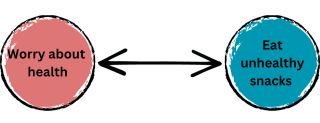Persuasion
An “Amazing” Way to Develop Your Mental Health
How to make sense of your struggle without losing your mind.
Posted April 3, 2023 Reviewed by Devon Frye
Key points
- Struggling with your mental health can feel like being trapped in a maze.
- Although your struggle may be complex, you can simplify it in small steps.
- Everything in your life is connected, and it likely plays a role in your struggle.
- There are eight key areas that contribute to your mental well-being.

Suppose you wake up one day, and you find yourself in the middle of a maze. The walls are too high to climb and too sturdy to break through. In front of you, however, are several openings leading down different paths—so you just pick one, hoping for the best. Every now and then, the way splits into multiple directions, and each time you have to choose anew.
Some people who have been in the maze themselves claim to have found the way out, and they tell you where to go. And then there are those who have made it their profession to guide people outside, and they have written smart books about it, filled with helpful advice.
Eventually, however, you notice there is something off. The guidance of other people doesn’t match your own experience, and you come across dead-ends where there should be open pathways.
Apparently, although many others have seen the maze before, they haven’t seen your particular maze, with its own unique outline and structure. And even worse: The maze itself begins to change. As you go along, new walls rise up and old paths disappear. The strategies that proved useful long ago suddenly no longer seem to work.
Making Sense of Your Mental Health
Struggling with your own mental health can feel like being trapped in a maze. Some days the path forward seems clear; other days you feel hopelessly stuck. And if you spend enough time inside, you may even begin to doubt that there is a way forward at all.
It’s not so much that you will find a way “out”—as long as you are alive there will be mental challenges—but there is always a way to create progress. It may look different from what you might expect, and for sure it will contain “problems”… but at least they will be new ones!
To move forward, you have to become an explorer. But don’t just stumble along from corridor to corridor. Instead, be smart and pay attention. Learn the location of dead-ends and open passages. Learn the rules within your maze. Bit by bit, notice more about what works and what doesn’t.
Start With a Simple Question
Although your struggle may be complex, you can start simple. Ask yourself this question: What is difficult for me? See if you can put your struggle in a few words, like “I’m a failure,” “I have no energy,” or even “everything sucks.” Whatever shows up, put it in a short statement. The more precise you are in your wording, the better.
Next, explore the pathways to and from your struggle. In process-based therapy (PBT), we investigate a person’s problem from multiple angles, to make sure we capture all relevant factors. This means we look at a person’s feelings, thoughts, behaviors, motivations, focus, sense of self, and even physical well-being, as well as their relationships and cultural context. All these dimensions give us valuable clues about a person’s struggle.
Let’s continue by looking at your behavior. What do you do when you are in the middle of your struggle? Are there certain habits that give you comfort? Or do you go into full fix-it mode? Whatever you do, see if you can put it into a few words as well, like “smoking a cigarette” or even “lashing out at others.”
We now have two clues about your problem: the essence of your struggle and your actions within it. And note that they are related; your struggle likely reinforces your actions.
In some instances, it’s also the other way around: your actions reinforce your struggle. Suppose, for example, that you worry about your health, and so you distract yourself by eating high-sugar snacks. Unfortunately, when you eat in an unhealthy way, you worry even more, leading to a self-reinforcing cycle. If you would draw these elements and their relationship, it might look like the figure below.

Now is your turn, write your struggle into one circle, and your action in another, and then draw an arrow to indicate how they influence each other. If you are not sure, that’s OK. Simply make a guess. You can always adjust it later on, as you learn more information.
Next, expand this map even further. You may already have ideas of which other factors influence your struggle, or which other behaviors you engage in when things are getting difficult. Now is the time to explore these other factors. In particular, you want to look at:
- Feelings (e.g. Which emotions show up? And how are they influencing you?)
- Thoughts (e.g. Which thoughts show up? And which role do they play?)
- Behaviors (e.g. What behaviors do you engage in? And how might this affect you?)
- Self-beliefs (e.g. What do you believe about yourself? And what role does this play?)
- Focus (e.g. What do you focus on? And how might this influence your struggle?)
- Motivation (e.g. What are you motivated by? And how might this affect things?)
- Body (e.g. What is the state of your physical health? And which role does this play?)
- Relationships (e.g. What is the state of your relationships? And how do they affect you?)
All of these areas give you valuable clues about your struggle, and they all play a role in your overall well-being. Ideally, you include as many elements as necessary to get a sufficiently complete picture—without adding redundant fluff. Your own experience is the best way to know whether something is important or not. If in doubt, add it, and then adjust later on.
Write each relevant factor in a circle, and then draw arrows, depending on how they influence other factors, based on your experience. You may even find some factors inhibiting others. For instance, “exercising” might inhibit your tendency to “eat unhealthy snacks.” In this case (just to remember) you might draw an arrow with an empty head, instead of a full one.
By paying attention and taking notes, you will begin to see the tangle of your own mental health as a system. Or to speak with the earlier metaphor: you will learn the outline and the structure of your maze, as well as the rules that keep you stuck. Once you know which choices maintain your struggle, you are better positioned to choose differently and notice the results.
Let your own life be your teacher; notice which strategies work, and which don’t. And one step at a time, this will help you move in a direction that will carry you forward toward a more vital life—one turn in the maze at a time.




